Oct 13, 2012 | cash, dollar, fun, video
Now that it has been three weeks since the autumnal equinox, the kind folks at the National Weather Service has issued a freeze warning for the Washington, D.C. area almost ending most outdoor activities. Aside from finding new coats for the dogs and their human parents and looking for a good charity which to donate the old coats, it is time to look for something to do indoors.
Being a blog about numismatics, I went on a search to find something a little different that the whole family could do when I stumbled on a YouTube video teaching the watcher “How to Make an Origami Dollar Ring.” It’s fun, functional, and costs only one dollar per ring.
Interestingly, the host of the video starts with showing how to use plain paper if you do not have a U.S. one dollar note. All it takes is using ordinary paper that is cut down to 15.5 cm in length and 6 cm in width. It is better to use metric measurements so that you can cut the sheet to the right size. Another advantage of using plain paper is that you can print anything on it prior to folding.
Here is the video to teach you what to do:
If you want to make your own ring using plain paper, I created a template based on the video’s instructions. The advantage of using the templates is that you can create your own design. After I folded my own dollar, I decided to make my own design based on the theme to this blog. Here are my results:
-
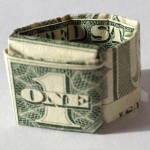
-
Origami Ring made using a $1 Federal Reserve Note
-
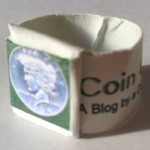
-
Origami Ring made using the the template colors of the Coin Collectors Blog
If you want to make your own ring, I created templates with lines showing the basic folds. I am including a blank template for you to create your own design and the template I used to make the Blog ring. Click on the link for the format you want and it will automatically download the file for you.
NOTE: When you click on the link above, your browser may open the file using the appropriate application on your computer. How this works depends on the browser you use and how you have it configured.
Sep 11, 2012 | commemorative, silver, US Mint, video
As we look at remembering those who died 11 years after the attacks on New York, Washington, and those who brought that plane down in Shanksville, Pennsylvania, the U.S. Mint published a video where they interviewed members of the die and polishing department about their part in the making of the 2011 September 11 National Medal.
As you heard in the video, you can still purchase the medal from the U.S. Mint with either the “P” or “W” mintmark for $66.95 each. The medals are one troy ounce of fine silver and the price includes a $10 surcharge that will be paid to the National September 11 Memorial & Museum at the World Trade Center in lower Manhattan.
It may also be time for congress to do something bipartisan and create a medal to raise funds for the Flight 93 National Memorial that will be erected in Shanksville. With the museum in New York and The National 9/11 Pentagon Memorial, it will complete the honor of those who died on that day. Then we can work on a memorial to honor the military who have shouldered the burden since.
Aug 8, 2012 | ANA, shows, video
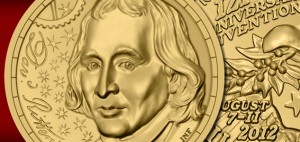
2012 World’s Fair of Money Medal
(image courtesy of the ANA)
While I do plan a few trips around the bourse floor, visit the exhibits, try to attend some of the Money Talks (formerly Numismatic Theater) session, and get a Rosie dollar autographed by Treasurer of the United States Rosie Rios, a good bit of the time you can find me either at the table for the Maryland State Numismatic Association (1159) or at the Gold and Silver Political Action Committee table (1155). I will be at the MSNA table Wednesday afternoon.
If you cannot make it to Philadelphia, you can follow me on Twitter (@coinsblog) and see what images I capture and pin to Pinterest. On Pinterest, I created a board for my images from the show. If I am not worn out, I will try to write about what I find here on the blog.
Whether you visit with me in Philadelphia (“On the whole, I would rather be in Philadelphia,” once quipped W.C. Fields) or follow online, it should be a fun week!
Stay tuned!
The story behind the 1792 Half Disme
Video courtesy of the ANA.
Aug 2, 2012 | coins, US Mint, video
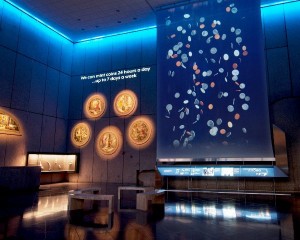
The new visitor lobby at the Philadelphia Mint
Eleven members of the media were invited to see the new tour area, access to the Mint floor, Mint employees, and other areas of the Mint not accessible by the public.
Tom Jurkowsky, Director of Public Affairs, was sure to point out that the project was, “on time and on budget.”
Finally, the Philadelphia Mint held an opening ceremony to 250 invited guests and Mint employees. Speaking at the ceremony included Associate Mint Director Dick Peterson and Treasurer of the United States Rosie Rios. The ribbon was cut by Rios flanked by Peterson and Jurkowsky.
You can download the brochure A Handbook to the Self-Guided Tour of the United States Mint [PDF] from the U.S. Mint’s website.
The U.S. Mint recently provided a video about the opening of the new tour area. You can watch it here:
Anyone attending the World’s Fair of Money next week in Philadelphia may want to consider taking the new tour and adding your comment about it here!
Jul 21, 2012 | Britain, medals, Royal Mint, video
With the 2012 Summer Olympics starting next week in London, the folks at CNN Money did a report about the making of the medals by the Royal Mint.
Medals made for the XXX Olympiad in London are the largest medals ever made for a summer Olympics. Their specifications are as:
- Diameter: 85mm (approx. 3.346 inches)
- Thickness: 7mm
- Weight: 412g (approx. 14.5 ounces)
- Designer: David Watkins
- Obverse Design: Nike with Panathinaiko Stadium in the background
- Reverse Design: The River Thames and the London Games logo with angled lines in the background
- Composition of Gold Medal: 92.5% silver, 6.16% copper, 1.34% gold
- Composition of Silver Medal: 92.5% silver, 7.5% copper
- Composition of Bronze Medal: 97% copper, 0.5% tin, 2.5% zinc
The metals used to make the medals were supplied by Rio Tinto and was mined at their Kennecott Utah Copper Mine and Oyu Tolgol project in Mongolia.
Here is the CNN Money report about the making of the medals by the Royal Mint:
Image of the London 2012 Olympic Medals courtesy of London Organising Committee of the Olympic and Paralympic Games
Video courtesy of CNN Money
Jun 26, 2012 | coins, national park quarters, video
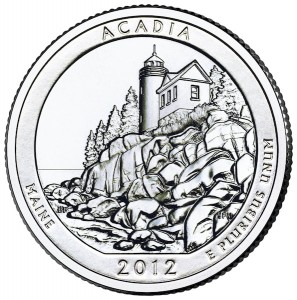 If you are going to be in the area of Acadia National Park today, June 26, the U.S. Mint will hold the launch ceremony at 9:30 AM at the Hulls Grove Visitors Center, Bar Harbor, Maine.
If you are going to be in the area of Acadia National Park today, June 26, the U.S. Mint will hold the launch ceremony at 9:30 AM at the Hulls Grove Visitors Center, Bar Harbor, Maine.
Scheduled to speak at the event are:
- B.B. Craig, Associate Director, Sales and Marketing, United States Mint
- Sheridan Steele, Superintendent, Acadia National Park
- Timothy Harrison, Founder, American Lighthouse Foundation
- Bill Green, Host, WCSH-TV’s “Bill Green’s Maine”
Rolls of the newly-minted coins, which feature an image of Bass Harbor Head Lighthouse, which, ironically isn’t actually in the park, will be available for sale.
For those who like video, and who doesn’t, the following is B-Roll footage from the U.S. Mint including a few seconds of U.S. Mint Sculptor and Engraver Joseph Menna working on the design of the coin using a computer. Coin was designed by Artistic Infusion Program Associate Designer Barbara Fox.
May 25, 2012 | Eagles, national park quarters, silver, US Mint, video
This week, the U.S. Mint branch in San Francisco opened its doors for the press in honor of the facility’s 75th Anniversary. Reporters were given a tour of the production lines and spoke with employees of the U.S. Mint about upcoming collectibles.
Here is the story that appeared on KTVU, Channel 2 in San Francisco (commercial embedded by KTVU):
The U.S. Mint has clearly increased production to meet a potential demand for the American Silver Eagle Proof set with both regular proof and reverse proof coins for the upcoming sale. In the video we see a lot of silver planchettes and a few racks of beautiful silver coins. A pair are shown to the camera including the reverse of the reverse proof.
We also learned that the San Francisco Mint is striking circulation quality (business strikes) National Parks Quarters that will be distributed in special collectibles. These coins will not be added into circulation.
San Francisco Mint Plant Manager Larry Eckerman made an unfortunate mistake when he said that there has not been any S mintmark coins in circulation since the early 1950s. Collectors of Lincoln Cents can tell you that S mintmark cents were issued starting in 1968 through 1974.
The 2012 American Eagle San Francisco Two-Coin Silver Proof Set goes on sale starting June 7, 2012. Coins will be minted to demand based on sales through the end date of July 5, 2012. Price will be determined prior to sale and based on the cost of silver. Here’s to hoping that silver prices drop between now and June 7!
Video courtesy of KTVU San Francisco.
Apr 13, 2012 | BEP, education, history, US Mint, video
Originally released on March 30, 2012 and updated on April 12, the Department of the Treasury updated their video honoring the history of women working for the U.S. Mint and the Bureau of Engraving and Printing over its history. The video also honors the 220th Anniversary of the U.S. Mint and the 150th Anniversary of the BEP.
Introduced by Treasurer of the United States Rosie Rios, the video shows how both the U.S. Mint and the BEP have a history of providing opportunities for women since each agencies founding.
Considering that women were considered second class citizens in the 18th century, it is amazing to find out that within two years the U.S. Mint hired two women to be adjusters. When the BEP was founded in 1862, women were hired alongside men and held the majority of positions within four years. I do not think any other agency in the U.S. government has a similar recrod.
Feb 25, 2012 | coins, education, US Mint, video
When I went to college for my undergraduate degree, the university’s programs did not include the ability to “minor” in a subject. Aside from the core courses, we were allowed to take eight classes in our major and four electives. Along with other requirements fill-ins I was able to take history and political science classes that would qualify as a minor today. It made taking some of those required courses tolerable.
History is what makes numismatics interesting. If you look beyond the shiny metal disks, you can follow the history of the country by studying the history of the numismatics. From the first Chain Cent through the Presidential Dollars, each coin tells the story of its time. What is even more amazing is that there are people researching further than ever before and finding new information that improves our knowledge. Others are looking at that history in different ways to better understand this history better.
When a friend sent a link to a recently discovered video about the manufacturing process at the U.S. Mint, I saw it as an opportunity to see where the U.S. Mint has come from. Ignoring the opening and closing titles from the company that posted the video which provides little relevant information, the film shows the process of manufacturing coins at the U.S. Mint in the early 20th century. Watch:
There is very little in the video to try to ascertain when the film was made. To try to date this film, let’s apply a little History Detectives-like logic. Looking at the video:
- Silent films started sometime in the late 1870s with experimental films. The first narrative film was created in 1888 and by 1894, silent movies began to be shown in public spawning the initial growth of local movie houses.
- The problem with early film was that the movies were in black and while and shown as very stark on the screens. Two methods were used to “mute” the shading. One was to shoot the movie darker using darker backgrounds and lighter foregrounds. The other was tinting. Tinting added color and contrast by using special solutions of salts or dyes replacing some of the silver particles in the developing solution. Tinting was first used in 1898 but was not used on a regular basis until the early 1910s.
- Intertitles, the full screen words drawn on paper and intermixed between scenes in the folk to help narrate the story, began in 1899 but were in common use by 1901.
- The silent film era began to fade quickly after the release of the first “talkie,” The Jazz Singer, in 1927.
Based on this, we can assume that this was filmed between 1910 and 1927. But what does the film show? A lot of manual processes but the use of electricity to drive the machinery. This does not help narrow the dating except there was a large mintage of silver coins being shown. At the beginning there were also large stores of gold and silver and it film showed how the metals were smelted, formed into bars, and rolled flat to make the planchets.
At around the 36-second mark, the intertitle says “Another tidy fortune—$60,000 worth of silver bars ready to be converted into dollars, half dollars, and church collection.” (emphasis added) Converting silver into dollars stopped in 1904 and did not start again until 1921. The scenes makes the U.S. Mint look very busy and the striking of silver dollars to back silver certificates were necessary following World War I. Remember, the Pittman Act was passed in 1918 to allow the the melting of no more than 350 million silver dollars into bullion where a total of 259,121,554 ounces were sold to Great Britain at $1 per ounce to help them pay for the war. When the silver was replaced by mining and being paid back by Great Britain, it became important to replace the melted coinage for backing of silver certificates.
Providing the maker of the film did not take a little editorial liberties, that shifts the date of the film in the era of 1921-1927.
At 3:59 an intertitle is shown that reads “A forty-ton friction drive press stamps the die which later stamps the coin.” Then at 4:07, we are show the top of the friction drive press that pans down to a Mint worker positioning the dies in the press. But the press does identify itself. Arching across the top it reads “TAYLOR & CHALLEN LTD ENGINEERS BIRMINGHAM 1907.” Then below on the house for the large screw it says “PRESS 724.”
 Taylor & Challen Ltd. Engineers were based in Birmingham, England. Founded in 1850 by Joseph Taylor, the company quickly rose as a leading maker of coining equipment. Their popularity came from being able to improve on the knuckle-joint action to efficiently strike and eject coins quickly from the press. According to one reference, the Model 724 was used in what we today call “hubbing,” the creating of the die by pressing the master hub into the die. What made the Model 724 well suited for this task was that the way Taylor & Challen was able to make construct the friction drive to provide the 40 tons of steady force at a slower speed than other presses to raise the clearest images on the dies with a single pressing. The U.S. Mint installed their first Model 724 in 1911 and was in use until 1933.
Taylor & Challen Ltd. Engineers were based in Birmingham, England. Founded in 1850 by Joseph Taylor, the company quickly rose as a leading maker of coining equipment. Their popularity came from being able to improve on the knuckle-joint action to efficiently strike and eject coins quickly from the press. According to one reference, the Model 724 was used in what we today call “hubbing,” the creating of the die by pressing the master hub into the die. What made the Model 724 well suited for this task was that the way Taylor & Challen was able to make construct the friction drive to provide the 40 tons of steady force at a slower speed than other presses to raise the clearest images on the dies with a single pressing. The U.S. Mint installed their first Model 724 in 1911 and was in use until 1933.
Just as Taylor & Challen out engineered their competition, they were out engineered by the Schuler company of Germany. Schuler invented the mechanisms to strike coins vertically so that gravity was used to speed up the striking process. Schuler remain the most popular presses around the world, including at the U.S. Mint. Taylor & Challen was never able to catch up and eventually went out of business in 1970.
As interesting as learning about Taylor & Challen was, it did not help narrow the date.
Unless I missed something, the only other observation was that most of the coins being shown in various forms were quarters. The bag tipping over at the end held a lot of quarters—Standing Liberty Quarters to be exact. So let’s say that this film was not taken in 1921 because the U.S. Mint was busy striking silver dollars. Since no quarters were struck in 1922, I can assert that the film was made between 1923-1927. I think that is as far as I can go with the evidence I can see.
If you have additional information or see evidence that I did not catch, please leave a comment to this post.
Image of the former Taylor & Challen building courtesy of Roger Marks on Flickr
Feb 6, 2012 | coins, commemorative, video
Your blog host is happy today as his favorite team, New York Giants, lead by MVP Eli Manning, beat the New England Patriots in Super Bowl XLVI. As a die-hard Giants fan, I worried if the team that was dominated by the 5-11 Redskins in Week 16 would show up or would the run that started the next week against the Jets continue. Like every game in the run, the Giants did just enough to hang in before putting the ball in Eli’s hands to let him do his magic.
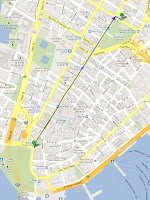 Next stop for the Giants is a ticker-tape parade down the Canyon of Heroes on Tuesday February 7. The Canyon of Heroes is the section of lower Broadway in the Financial District that runs from Bowling Green to City Hall Park.
Next stop for the Giants is a ticker-tape parade down the Canyon of Heroes on Tuesday February 7. The Canyon of Heroes is the section of lower Broadway in the Financial District that runs from Bowling Green to City Hall Park.
The game started like every other football game does with the coin toss. For the last 21 Super Bowls, including Sunday’s Super Bowl XLVI, the Official Coin used for the coin toss is made by The Highland Mint of Melbourne, Florida.
You can find out more about how the coin is made complements of FloridaToday.com:
The Highland Mint strikes 10,000 coins and are numbered. The first 100 are sent to the NFL where number 1 is used for the coin toss. After the game, it is sent to the Pro Football Hall of Fame in Canton, Ohio.
In the following video, you can see more of the manual aspects of the minting process, including the gentleman sitting at a machine that stamps numbers into the coins which is shown in the second-to-last scene.
If you are a member of the Papa Rewards Program, the loyalty program for Papa John’s Pizza, your interest in the coin toss ended when it landed on heads and you won a free pizza and soda. Enjoy your pizza!







